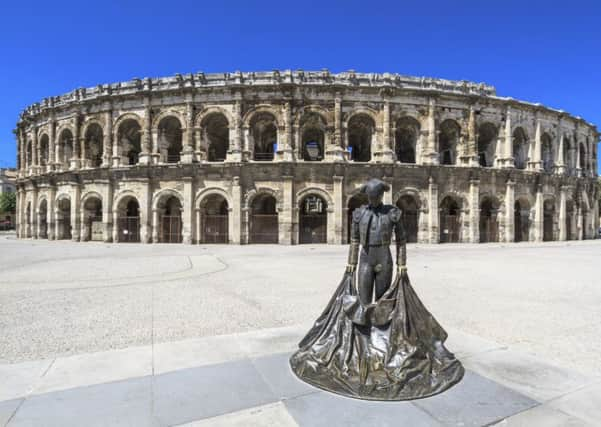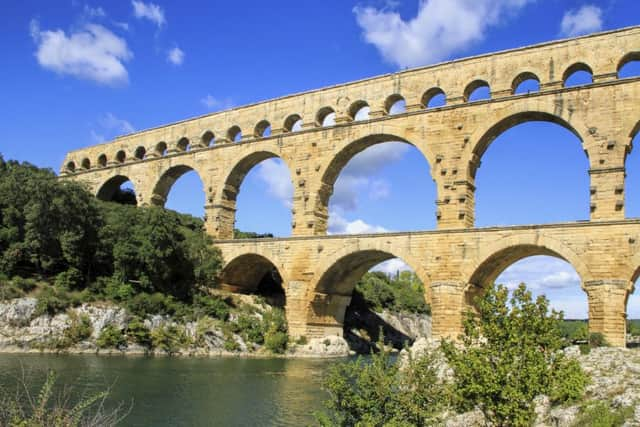Travel: Enjoying the splendour of Nîmes, France
This article contains affiliate links. We may earn a small commission on items purchased through this article, but that does not affect our editorial judgement.


No, we don’t want to bother going to Nîmes, I was there 30 years ago and it was a bit of a dump. Not a patch on Arles just down the road.”
“But we’ve visited Arles before and we’ve seen Marseilles, Aix and all the other notable sites round here – let’s have a squizzy at the amphitheatre at least.”
Advertisement
Hide AdAdvertisement
Hide AdSo off we set from our base at Saint-Mitre-les-Remparts in our hire car. A word about cheap car hire: when you book you may well opt for fully comp insurance. However when you pick-up, your web-based agent’s insurance is invariably rubbished and the hard sell begins – another €75 euros for the local cover. “Mais, monsieur, it will cost €1,500 for even a tiny scratch if you don’t take this,” said the charming young lady at the counter. “No it won’t,” I said, “last time you tried to charge €180 but I had proof the car was pre-dented and my credit card company made you refund me.”


All this became quite farcical when we walked out into the Provençal sunshine and found a Fiat Punto so scratched, dented and ill-used that it was impossible to record all the marks on the fiche d’état du véhicule. The manager shrugged “C’est Marseille!” as he signed it off.
(It is worth considering an independent annual top-up cover policy if you hire abroad with any frequency.)
Two weeks previously, a glance at flights from Edinburgh to Marseille had shown an astonishing late bargain was there for the taking and an hour on the net furnished a week’s accommodation at the brand new Résidence la Provence at Saint-Mitre just outside Martigues. This proved exceptionally good value for money offering a sparklingly clean and comfortable apartment and pool with extensive views across the Étang de Berre. Run by a large friendly family, we soon got into a good-natured exchange about French and Scottish rugby teams.
Although our French is pretty good, it is very noticeable how much more outgoing towards non-francophones our Gallic amis are these days. Gone are the 20th century blank looks of (supposed) incomprehension; English is now invariably met with courteous assistance and genuine pleasure.
The approach and outskirts of Nîmes proved a colourful flower-filled experience and clear signs for centre-ville and parking arène soon had us leaving the Fiat Dento in a spacious underground facility in the heart of the old city. Up the steps and – Wow!
A lot has happened to Nîmes since my previous encounter. A renaissance of reconstruction in the 80s and 90s has combined cutting-edge contemporary art with the riches of the past. The old districts have been renovated and architectural and town planning projects have been entrusted to international names – with Norman Foster, Gregotti and Kurokawa among them.
Emerging into the wide spaces of the Esplanade Charles de Gaulle reveals a vivid modern park populated with cafes and rest areas sheltered from the Mediterranean sun. The scene is dominated by the massive façade of the best-conserved amphitheatre of the Roman world, sparkling brightly in its freshly cleaned raiment.
Advertisement
Hide AdAdvertisement
Hide AdA visit to this has to be worth the trip alone, but first we pop into the Pavilion de l’Esplanade tourist office where a friendly and helpful Nîmoise provides a map of the town and suggests the best things to see. She flatters by asking if we prefer the plan en français ou anglais.
Nîmes owes its existence to Julius Caesar’s successful Egyptian campaign: the returning legionnaires earned plots of land at Nemausus on the Via Domitia highway to Rome and adopted the crocodile and palm tree as symbols for their town. These can be seen everywhere – on the myriad fountains, stone motifs on buildings and brass studs in the pavement.
As Nemausus grew, the demand for water drained the local springs. So with typical single-mindedness, the Romans dug a 50km canal to bring water all the way from Uzes, (constructing the fabulous Pont du Gard aqueduct on the way to overpass the River Gard.)
And so we enter the amphitheatre. This colossal structure holding 20,000 spectators was built for gladiatorial combats and wild animal spectacles. The useful audio guide explains all the different types of gladiator – Thracians, Mirmillones, Retiarii, Secutores – the combinations, rules and scoring systems.
Combats were well regulated and the knowledgeable crowd appreciated the finer points of each encounter – like a bloodier version of today’s Wimbledon.
Unfortunately as the Empire crumbled the supply of professional gladiators dwindled and the contests became crude fights to the death between ill-trained thugs, bruisers and criminals.
After the Barbarian invasion, the arena was converted to a fortress and later fell into disrepair with a stinking village growing inside the walls. These were forcibly removed at the end of the 18th century and the edifice restored to its former magnificence. Today it is used for concerts, festivals and Camargue bull fights, where the toreros pluck favours from the bull’s horns rather than killing him.
A stiff climb to the top of the tiers of seating gives a dramatic view over the city’s rooftops – and vertiginous glimpses down into the old town streets far below. Not for the faint-hearted.
Advertisement
Hide AdAdvertisement
Hide AdOur plan told us that a stroll through the old town would show many of the great 16th, 17th and 18th century mansions and opulent squares that evidence the city’s prosperous history of textile manufacture. For centuries wool, cotton then silk bestowed growth and celebrity. The city of course gives its name to the universal material of our age. Blue dye from Genoa (Gène) was used to preserve and protect the local cloth which was exported as serge de nîmes – contracted to denim and jean(s). Levi Strauss ordered large consignments for workwear and mistook the initial delivery batch number 501, as a code for the material: thus one of the today’s famous trademarks was born.
The old town combines a wonderfully time-balanced admixture of squares, fountains, restaurants, boutiques and ancient structures – the old Roman gates, the Maison Carrée that once bordered the forum. Surrounding this, the fresh creations of the 21st century – the Carré d’Art, the Nemausus apartments – complement beautifully. By now my old view of Nîmes had been stood on its head. The icing on the cake was provided by a visit to the Jardins de la Fontaine; one of the major public gardens in Europe. Laid out in the 18th century on the site of the ancient spring, the remains of the Roman Temple of Diana and the Tour Magne were incorporated into the grand plan.
Used by Benedictine monks, the Temple had remained intact into the Middle Ages but fell victim to the murderous strife of the Protestant Wars. It was ransacked by Hugenot mobs leaving the eerily quiet shell in its leafy bower that we see today. It is difficult to leave the magnificence, and yet peace, of the gardens with their cool fountains and carp-filled canals.
All these wonders are within a short walk of each other: Nîmes must offer one of the best short-break destinations in Europe. Add Provençal food and refreshing rosé wines and this place is unmissable.
• Flights with Ryanair (www.ryanair.com) from Edinburgh to Marseille start from under £100 return. Accommodation at the Résidence la Provence is available under £500 per week (www.booking.com).